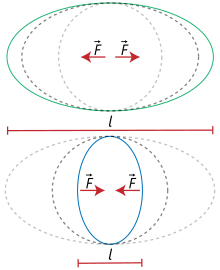strain
The elongation ( symbol :) is an indication of the relative change in length (lengthening or shortening) of a body under load, for example due to applied forces or a change in temperature ( thermal expansion ). If the size of the body increases, it is called a positive stretch (stretching), otherwise it is called a negative stretch or compression .
definition
The elongation is defined as:
Here is the change in length and is the original length . The elongation is given as the size of the number dimension , also multiplied by 100% as a percentage . The values of and are usually measured directly on the test specimen .
In the technical field, it is also common to specify the elongation in micrometers per meter (µm / m). For this, derived from Mikroepsilon, the notation µeps or µε is also used. 1 µm / m corresponds to 0.0001 percent, a 1 percent elongation corresponds to 10,000 µm / m.
For many materials the elongation is proportional to the acting stress within certain limits , which is expressed by Hooke's law in the linear-elastic range. The relationship between stress and strain is called the modulus of elasticity . As a result of the transverse contraction , there is also a secondary expansion with opposite signs transversely to the direction of force and to the primary expansion. The ratio of transverse and longitudinal expansion is called the Poisson's number .

In a general loading scenario, tensile, compressive and shear forces can also occur in combination. This also results in complex expansions in all three spatial directions. The state of strain is also dependent on the underlying reference system . When the square disk is stretched in the image, a shear γ also occurs. The complete mathematical description of the state of strain, which does justice to this fact, takes place via tensors of the force or strain. The strain tensor ε is - like the stress tensor σ - fundamental for the elasticity theory of solid bodies ; In particular, they form the basic framework for computer models of deformation simulation, as can be carried out using the finite element method , for example. The relationships between the stresses and strains can be graphically displayed and evaluated using stress-strain diagrams and the dependency on the orientation of the reference system in the form of Mohr's stress or strain circles.
Technical elongation
When considering strains as a response to two (or more) successive forces, two different reference systems are used for calculating the strain. If it is given in relation to the initial length before the first application of force, it is called technical elongation . This method is particularly simple because the initial length is then a constant . Technical stretching is also called Cauchy stretching .
However, it has the disadvantage that the sum of two partial elongations does not equal the total elongation:
- is not the same as .
However , as long as :
- or and with it .
Logarithmic expansion
In contrast to technical stretching, logarithmic or “true” stretching is related to the current length of the body, after it has already been pre-deformed by previous forces (and also called Hencky stretching ).
It is defined by:
- and thus , with the main extensions in the respective direction.
From a mathematical point of view, the technical expansion is a series expansion of the formula for the “true” expansion into a Taylor series with a break after the first term. For small strains there is therefore the relationship between the two definitions:
- .
Nominal elongation
As nominally the strain is designated when the measured values and can not be determined on specimens, but between the grips of the testing machine. This type of strain determination is used for materials that can be deformed beyond the measuring range of the extensometer .
See also
- Strain sensor
- Uniform expansion
- Elongation at break
- Degree of deformation
- Strain tensor
- Continuum mechanics

















